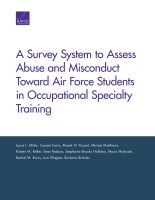| 来源类型 | Research Reports
|
| 规范类型 | 报告
|
| DOI | https://doi.org/10.7249/RR2692
|
| ISBN | 9781977402035
|
| 来源ID | RR-2692-AF
|
| A Survey System to Assess Abuse and Misconduct Toward Air Force Students in Occupational Specialty Training |
| Laura L. Miller; Coreen Farris; Marek N. Posard; Miriam Matthews; Kirsten M. Keller; Sean Robson; Stephanie Brooks Holliday; Mauri Matsuda; Rachel M. Burns; Lisa Wagner; et al.
|
| 发表日期 | 2019
|
| 出版年 | 2019
|
| 页码 | 204
|
| 语种 | 英语
|
| 结论 |
- Power imbalances and career influence over students in occupational training pipelines may increase the risk for abuse and misconduct.
- Without confidentiality, the survey will lose its value in promoting visibility of behaviors that students are not willing to reveal through official reporting channels.
The survey system needs to address diverse occupational training pipelines- Pipeline length can range from a few weeks to more than a year.
- Pipelines may require training at one, two, or several installations.
- Some training is run by the other branches of the military.
- Courses may have many students or only a few.
- In some courses, newly enlisted airmen train alongside officers and/or enlisted airmen with greater tenure.
There are two primary options for survey administration- One option is administering the survey at a single point, capturing a snapshot of all technical training or flying training students at that time.
- The second option is connecting the administration of the survey to the training pipeline itself (e.g., by surveying students at the end of the awarding course).
- Both census (entire population) and sampling approaches have strengths and limitations.
- The survey must ask students about specific behaviors to jog their memories and to avoid problems stemming from differing understandings of terms, such as "hazing" and "sexual harassment."
- If not managed properly, differences in pipelines could lead to misleading comparisons of incident rates.
- Software and computers will need to be updated to support a survey tailored to different types of students dispersed across a wide array of training locations.
|
| 摘要 |
Survey timing should be timely to avoid recall problems- Survey enlisted students at the end of their training pipelines or at approximately six months, whichever comes first.
- Survey officers in undergraduate pilot training at the end of primary training and at the end of advanced training.
- Prior to their exits, survey students who leave training without graduating.
All students should be invited and permitted to participate; however, participation should be voluntary- Ask flight commanders and chiefs to encourage participation.
- Coordinate administration with other surveys to reduce survey fatigue.
Employ strategies to ease access and promote open and honest participation- Build survey time into student schedules.
- Explore options for taking the survey on personal computers or devices.
- Allow only students and a civilian survey administrator to be in the room during the survey.
- Ensure that students stay for the full survey session to protect against pressures to rush through it.
A full-time civilian behavioral or social scientist with relevant expertise and resources should manage the survey analyses and reporting- Provide reports of survey results every six months to establish a stable baseline and then annually and as needed.
- To protect confidentially, do not report separate results for any group with fewer than 10 individuals.
- Present survey results in context; include information that may explain changes over time (e.g., policy changes, staffing changes).
- Protect the unique contribution of the survey by not allowing it to be used as an investigative tool.
|
| 主题 | Gender Integration in the Military
; Military Education and Training
; Sexual Assault
; Sexual Harassment
; Survey Research Methodology
; United States Air Force
|
| URL | https://www.rand.org/pubs/research_reports/RR2692.html
|
| 来源智库 | RAND Corporation (United States)
|
| 引用统计 |
|
| 资源类型 | 智库出版物
|
| 条目标识符 | http://119.78.100.153/handle/2XGU8XDN/108987
|
推荐引用方式
GB/T 7714 |
Laura L. Miller,Coreen Farris,Marek N. Posard,et al. A Survey System to Assess Abuse and Misconduct Toward Air Force Students in Occupational Specialty Training. 2019.
|
|
文件名:
|
x1551792545200.jpg
|
|
格式:
|
JPEG
|

|
文件名:
|
RAND_RR2692.pdf
|
|
格式:
|
Adobe PDF
|
除非特别说明,本系统中所有内容都受版权保护,并保留所有权利。